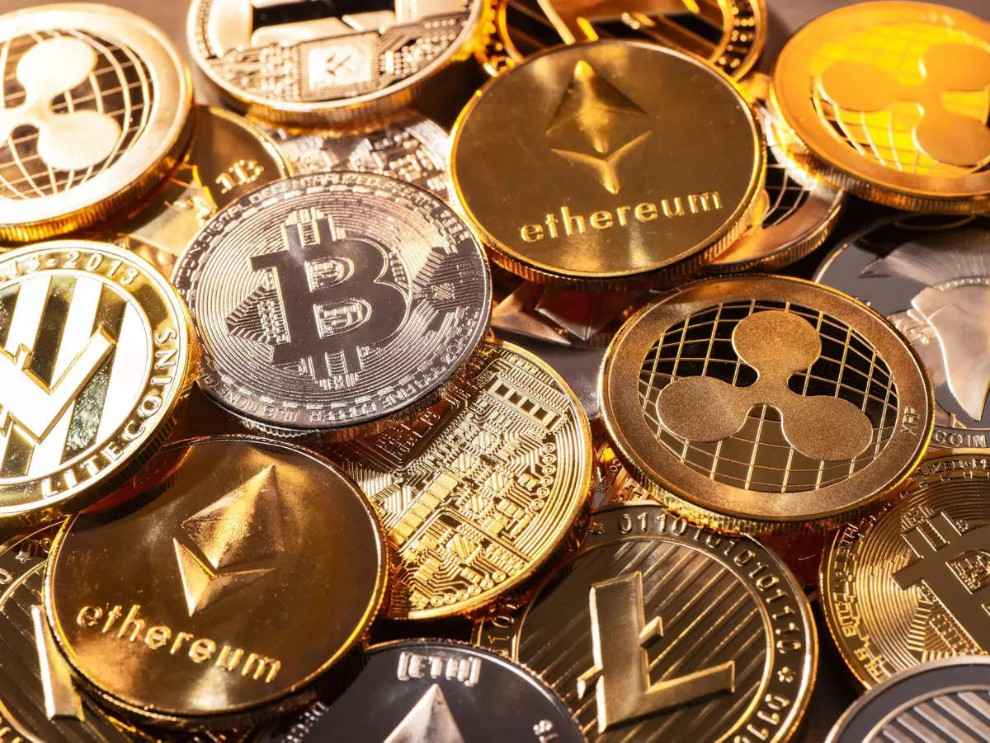Finance in the Metaverse: Show Me The Money

So how will finance work in the metaverse?
Could there even be a financial system in place?
In this article, we'll take a look at exactly that.
The metaverse will use cryptocurrencies supported by blockchain.
I wanted to put just that one sentence above as the entire article in the middle of the web page. I thought I was being very creative. My editor, however, thought I was being very lazy, and the SEO guy's brain froze for 15 minutes as he went into a feedback loop. After being yelled at, I will now use ~1.6K words to elaborate that same sentence into an "article".
Crypto
Of course it will be cryptocurrencies that rule the many metaverses that will pop-up, but there’s going to be chaos. And why wouldn’t there be? It’s a made-up economic system, used to transact in a made-up world, to buy things that are made-up. Add to that the complexity of every service making up their own money, and no real way to decide on the value of that money against real money, except for demand, despite the made up money being totally worthless outside of the service it was invented for. A word salad that!
Let’s look at an example.
Two major metaverse projects are Decentraland and Sandbox, and both have their own crypto currencies. Just as in life, in order to do anything of meaning and excitement in these early metaverse offerings, you need money. In Decentraland you need MANA, their digital currency that’s powered by the Ethereum blockchain. In Sandbox you need SAND to trade, and their cryptocurrency is run on blockchain. As of writing this, the value for SAND is about $4.88 and MANA is $3.12. That’s them being equated to real-world, US dollar values.
In simplistic terms, we know how the US dollar evaluation is arrived at, or for that matter all currencies of the world. All currencies have relative values, and are pretty useless in isolation. This is because the world depends on import and export, and trading and sending money to and from other countries. Thus, currencies have to be evaluated against one another, and that’s done in a super complex manner that one needs a degree or two in economics to truly understand.
However, in its simplest form, an exchange rate is a simple supply vs demand equation. More people buying Indian Rupees, and the value of it increases, fewer people buying drops the value, and more people selling Indian Rupees to buy other currency causes the value to fall even faster. The more INR held in reserves by countries across the globe means that there is less INR in circulation, which makes the value of INR higher.
Real-world links
Of course, what people are buying and selling are not actual, physical Indian Rupee notes, it’s import and export, investing in an Indian company, or conversely divesting an older investment. Foreigners (people, governments or companies) investing in India, buying exports from India or even just tourists visiting and changing currency to INR to spend in India, all of that are activities that raise the value of the Rupee. There are other factors, such as the GDP of a country, the purchasing price parity, the stability of a government, what policies it enacts, whether it’s at war or not, etc, which all have to be factored in as well. It’s just a lot easier to look at it through the supply / demand lens.
Now, while all of these physical currencies are related to one another, they’re benchmarked against a standard currency, such as the US dollar, which allows the whole world to trade with one another. And this trading is kept fair based on promises by the governments of each country. This is why notes have the ‘promise to pay’ message of the head of the financial institution or the president or leader of the country.
Cryptocurrency on the other hand is effectively valued based on scarcity and popularity. Bitcoin, for example, has a fixed maximum circulation which means that its value can fluctuate on a daily or weekly basis, but as long as it stays popular and in demand by an increasing amount of people, the value should only rise. We say “should” because there are plenty of other factors at play as well. For example, governments could make it illegal to accept bitcoin as a currency and ban it. This would hurt its value.
Made up?
So are crypto currencies just made up and essentially useless? Yes and no. As long as they’re popular, they’re valuable, and you can trade in them, but at a risk. The risk comes from factors outside the cryptoworld usually, such as the government intervention we pointed to earlier. Then there is also the risk of a project that a cryptocurrency was attached to dying out. A competitor could make a product or service that’s much better, causing the popularity of a game or service to reduce drastically, and that too would kill the currency (supply and demand remember).
Three decades or more ago, a lot of Indians used to favour investments in gold. Lessons learnt from the world wars, the partition of India, and financial depressions caused people to realise that paper money could become unreliable in times of strife, but gold was always valuable.
Bank accounts can be frozen and become useless to a person. Governments could (in theory) usurp land or declare an individual or a company broke with the stroke of a pen. This has happened before, an example is the persecution of Jewish people in Germany during Hitler’s reign. Freedom can be lost, which is exactly what happened to Japanese-Americans during their war with Japan. Banks could collapse because of mismanagement, or a stock market could collapse due to a recession, but owning physical gold was considered a safe bet, because gold can be sold in other countries, even when your currency is rendered useless.
So what’s the physical and tangible asset that cryptocurrencies have to back them up? What’s the equivalent of gold in a digital universe?
NFTs?
Short for non-fungible tokens, NFTs are sort of an attempt to give the crypto world something even more unique than gold. When something is fungible, it means that only the amount is important, not the thing itself. So a hundred rupee note is exactly the same value as another hundred rupee note. As long as it was not counterfeit, I could take your old Rs 100 note and give you a crisp, new, Rs 100 note, and there would be no difference to your financial situation whatsoever.
Thus, when something is non-fungible, it’s irreplaceable, or one of a kind. This should be better than gold in the real world, because even gold is fungible, as a 1 kg brick of pure gold is still worth the exact same as another 1 kg brick of pure gold. And in theory, NFTs are in fact unique, and are (usually) stored in an Ethereum blockchain.
The problem is, that’s like you investing in gold, giving it to your bank, who then lists it in your bank account in terms of cash. If the bank goes under, so does your gold along with your money, thus making the whole exercise of buying gold pointless. Same thing with the cryptocurrency and NFTs, because even if an NFT is stored in a different part of a blockchain, it’s still susceptible to all the same risks as the cryptocurrency itself.
Most NFTs being sold right now are digital art, but whatever they may turn out to be later, they’re still going to be purely digital things, and have to be stored on a blockchain and assigned to an individual. There’s nothing physical you have that can stake your claim to your wealth if it’s measured in NFTs.
Cryptos will rule the Metaverse
FOTDA
That stands for fear of the digital apocalypse, and it’s not a well known acronym because we just made it up. It is a feeling that dates back to the Y2K days, though the amount of people fearing a digital apocalypse in 1999 was almost insignificant by modern standards, it was still a big deal at the time. It was a feeling that re-emerged in financial circles with the bursting of the dot com bubble in 2001. That and the shutting down or winding up of so many sites and services we used to take for granted, such as Orkut, Google+, BlackBerry, MySpace, Google Glass, and more.
And what it’s done is make us very wary of digital promises that are huge and world changing. Cryptocurrency and everything crypto has to be the biggest change we have seen in the digital world, and it makes the dot com hype of the late `90s pale in comparison. However, it’s a bandwagon nonetheless, and there will be billions lost on it eventually, because not all crypto companies will be successful in the end. Not even a significant percentage of them will survive, if past history is any indicator, and the best most can hope for is to be taken over by bigger companies. A lot like how internet companies today are usually bought up by one of the big tech giants.
Of course, that doesn’t help you, the little guy investor, who might back the wrong coin, but that’s how unfair everything financial has been for a while now.
Still Crypto
And yet, it will be crypto that will rule the metaverse, because there is no other option yet, and it seems unlikely that a new one will come along anytime soon. Instead, we will get governments backing their favourites, or some other governments outlawing crypto totally (because of how easily it can be used for illegal transactions), and there will be a mess, but it will eventually settle down to whatever the US and Europe decide to adopt, because they have the financial power to govern the space.
We expect more and more banks and governments to get on the bandwagon, and legalise or legitimise cryptocurrencies, which will make it spread a lot faster to the digital natives of the world. In fact, many services might adopt it so seamlessly that you won’t even notice the difference. However, in no way can you afford to be ignorant of the way cryptocurrencies work anymore. All of us have to take them very seriously and educate ourselves about it, because for now, they’re not going anywhere.
And don’t worry about cryptocurrencies being ‘made-up’ as I described them earlier, because even the current financial system is essentially made-up too!
Read more articles about the Metaverse.
This article was first featured in the January 2022 issue of the Digit magazine. To subscribe to the magazine, head to this link. To get the digital subscription, head over to Geek.Digit.in
Agent 001
I have a keyboard and I'm not afraid to use it, because I have a license to quill. View Full Profile





